THE “HOODOO” BURGLAR OF BEDFORD (1904)
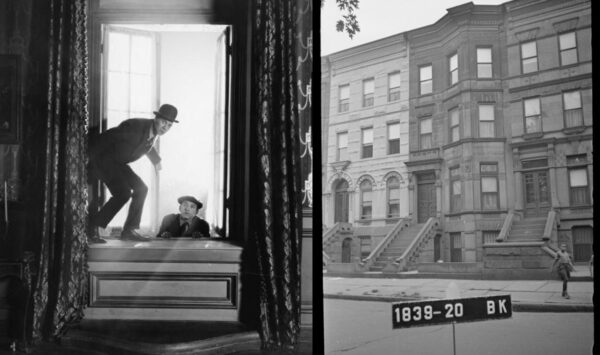
******************************************************************************************************************************** Brownstone Detectives investigates the history of our clients’ homes. The story you are about to read was composed from research conducted in the course of one of those investigations. Do you know the history of YOUR house? ******************************************************************************************************************************** “In the arrest of Roy Hyden, a 25-year old Austrian, early this morning, Brooklyn’s most active burglar was run to earth and a heavy load lifted from the police mind. “Henry F. O’Connell, a special officer, who is employed by the residents in the neighborhood of Jefferson and Marcy avenues to watch their homes at night, caught the man shortly after 3 o’clock this morning, “with the goods on him.” O’Connell espied Hyden coming down the stoop of the home of Mrs. Maria C. de Porozo, at 254 Jefferson avenue, staggering under a weight, with his pockets bulging; the bay parlor window was wide open. Before Hyden reached the bottom of the stoop he was in the firm grasp of O’Connell. The latter lost no time in calling a patrol wagon and the prisoner was hustled to the Gates avenue police station. There he was joyfully received by Detective McGann, who relieved him of his burden. “No less than sixty-four pieces of silver, including knives, forks, spoons and other small diningroom articles, weore fished out of his commodius pockets. But what pleased the police more than all “the silverware, was a steel case-opener and an electric flashlamp, which were carefully stowed away in the lining of the prisoner’s overcoat. Hyden gave […]
NEW YORK’S MOST BEAUTIFUL WOMAN (1901)
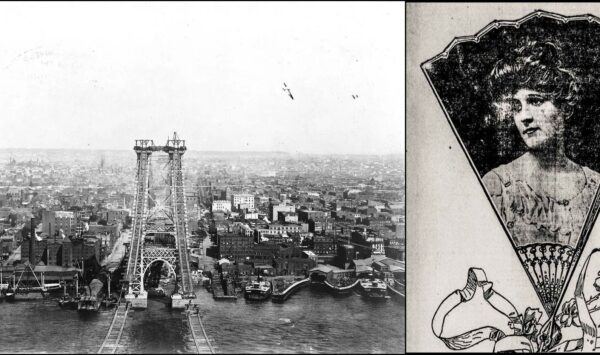
******************************************************************************************************************************** Brownstone Detectives investigates the history of our clients’ homes. The story you are about to read was composed from research conducted in the course of one of those investigations. Do you know the history of YOUR house? ******************************************************************************************************************************** (From the Akron Daily Democrat, Sat., 16 November 1901.) Miss Harriet Sewell Smith, formerly of No. 177 Putnam Avenue & presently of No. 481 Franklin Avenue, who was selected by a committee of portrait painters as “THE MOST BEAUTIFUL WOMAN IN NEW YORK” and who lives with her father, Dr. E. F. Smith, in Brooklyn, tells the story of a perilous trip she made across the frail foot-bridge of the new East River bridge a week ago. Miss Smith made the journey from one shore to the other in less than an hour. Her companion and guide was Dr. Orville D. Westall, a dentist, of No. 98 Lafayette ave., says she: “Dangerous? Yes, just dangerous enough to be interesting. I heard Dr. Westall mention some time ago the fact that he had crossed the footbridge, and I immediately became possessed of a desire to perform the hazardous feat myself. I proposed that he be my guide, and he accepted, after some persuasion. “I did not tell my folks what I was going to do. We started from the New York side at 5:30 in the evening. I had a leather belt fastened about my waist to which a strap was attached. Dr. Westall kept a firm grip on this strap and […]
THE FARMS LINES OF BROOKLYN (1874)
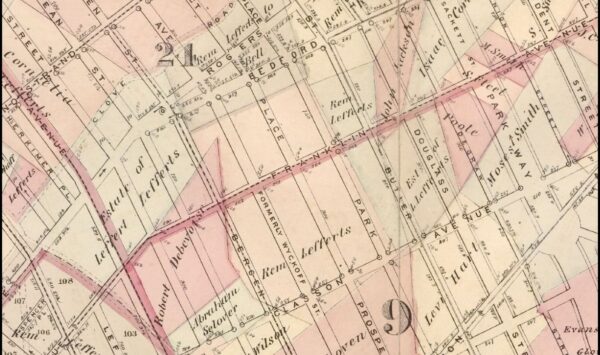
******************************************************************************************************************************** Brownstone Detectives investigates the history of our clients’ homes. The story you are about to read was composed from research conducted in the course of one of those investigations. Do you know the history of YOUR house? ******************************************************************************************************************************** Brooklyn was once one giant farm. At some point, as the farms began to be split up to be sold to developers – those who wanted to build rows of prized brownstones – companies also began to pop up which developed maps showing what types of buildings existed on every “lot” within the city. Although no longer used for fire insurance purposes, they are great tools for those owners wishing to research the histories of their properties. If you own a home in New York City, these maps can help you to determine how old it is, what else had been built in the area when your house was new, and, on some maps, the name of the farmer that had once owned your land. Find yours HERE. Follow @BrownstoneDetec Share ———————————————————————————————————————– The Brownstone Detectives Brownstone Detectives is an historic property research agency. Our mission is to document and save the histories of our clients’ homes. From our research, we produce our celebrated House History Books and House History Reports. Contact us today to begin discovering the history of your home.
SACRIFICED TO A FEED A BRIDGE (1907)
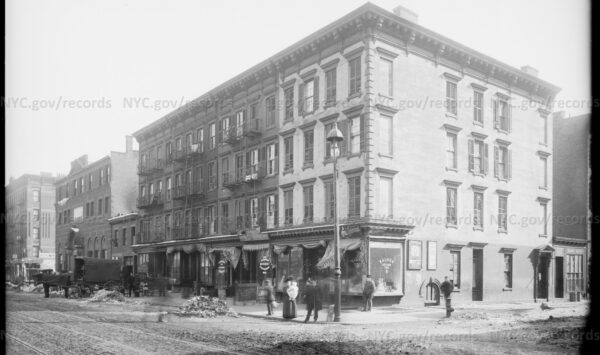
********************************************************************************************************************************Brownstone Detectives investigates the history of our clients’ homes.The story you are about to read was composed from research conducted in the course of one of those investigations.Do you know the history of YOUR house?******************************************************************************************************************************** Most New Yorkers know it when they see it – the Manhattan entrance to the Queensborough Bridge. It’s congested with vehicles, cars, and pedestrians – all just trying to get onto the bridge or around it. Most people, though, don’t know what this area looked like before the bridge was built. In 1907, fortunately for us, someone went around and took pictures of the rows of buildings – mostly wooden – that were doomed to the woodpile, soon to be sacrificed to feed that bridge. In these pictures, you will see life continuing to go on around these buildings. If you look closely, though, you will see something rarely seen in old pictures of New York City life – everyone is preparing for the end. Moving vans abound. Sales are announced. You can even see it in the faces of the subjects: “There is not much time before this is all gone…” To the feint of heart, everything you are about to see – is no more… These are those pics: To see these pictures in their glorious hi-res detail, check out this part of the New York City Department of Records Photographic Collection by clicking HERE. Follow @BrownstoneDetec Share ———————————————————————————————————————– The Brownstone Detectives Brownstone Detectives is an historic property research agency. Our mission is […]
THE MARXIST AT No. 477 E. 16th St. (1910)
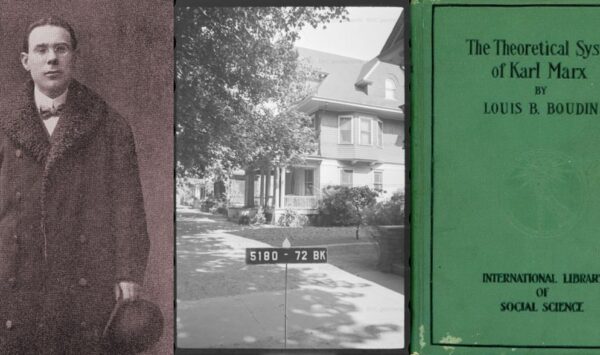
******************************************************************************************************************************** Brownstone Detectives investigates the history of our clients’ homes. The story you are about to read was composed from research conducted in the course of one of those investigations. Do you know the history of YOUR house? ******************************************************************************************************************************** At No. 477 East Sixteenth Street lived a Socialist. He wasn’t your ordinary, run-of-the-mill Socialist, however. Louis B. Boudin was a Russian-born American Marxist theoretician, writer, politician, and lawyer, who wrote a two volume history of the Supreme Court’s influence on American government as well as his piece de resistance, The Theoretical System of Karl Marx in the Light of Recent Criticism, first published in 1907. Boudin’s family emigrated to America in June 1891 and settled in New York City. He worked in the garment industry as a shirt maker and as a private tutor. At the same time, Boudin began legal studies, gaining a Master’s Degree from New York University and being admitted to the New York State Bar Association in 1898. At first, Boudin was a member of the Socialist Labor Party of America. He was also a member of the governing National Executive Board of the party’s trade union affiliate, the Socialist Trade and Labor Alliance from 1898 to 1899. Although he left the party for a short period, he returned after the turn of the century, being elected a delegate of the Socialist Party of America of the International Socialist Congress in Stuttgart in 1907 and the 1910 Copenhagen Congress of the Second International. Boudin was frequently […]
HOW TO REMOVE A BROWNSTONE STOOP (1905)
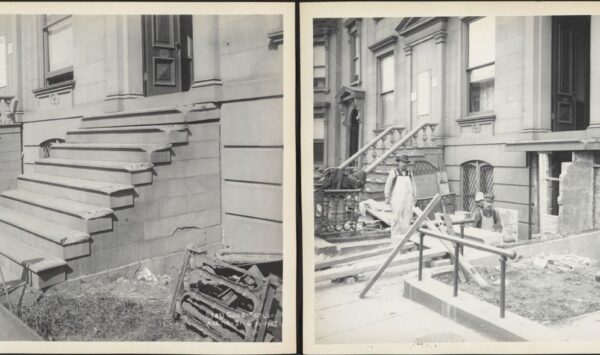
******************************************************************************************************************************** Brownstone Detectives investigates the history of our clients’ homes. The story you are about to read was composed from research conducted in the course of one of those investigations. Do you know the history of YOUR house? ******************************************************************************************************************************** Today, brownstone owners shake their heads in wonder. “Why would anyone intentionally remove the stoop from their own townhouse?” they muse. The stoop, like a timeless portrait’s gilded frame, is a vital element to the design and use of the townhouse. It carries the focus of the viewer into the house itself, just as the stoop physically transports the resident bodily into the house. A brownstone house simply cannot exist without its stoop. Well, like shag carpeting in the 1970s, stoop removal was all the rage in the 1940s. “Remove your stoop and turn your brownstone into apartments,” was the sage advice of contractors hoping to bring their clients’ properties into the 20th century. “Remove your brownstone stoop and add value to your property,” they said. If you didn’t see it happen, though, with your own eyes, you might assume that the destruction was merely accidental. Perhaps a car crashed into the structure and damaged the stoop beyond repair, or time and the elements slowly destroyed the stoop. Well, here, thanks to the New York Historical Society, we have pictures – in all their “glory” – of the “before,” “during” and “after” snapshots of the destruction of one of those august brownstone set of steps. These, documenting the disappearance of a […]
THE DUKE OF No. 210 ST JOHNS PL (1907)
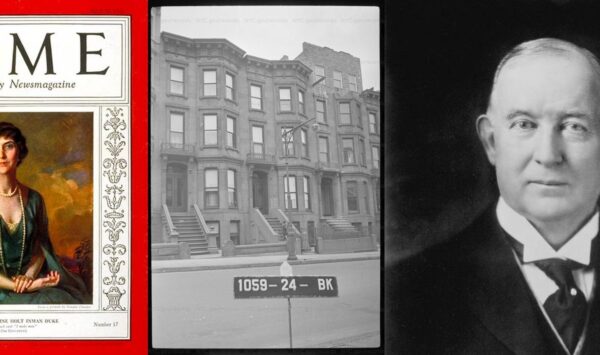
******************************************************************************************************************************** Brownstone Detectives investigates the history of our clients’ homes. The story you are about to read was composed from research conducted in the course of one of those investigations. Do you know the history of YOUR house? ******************************************************************************************************************************** In 1907, a quiet wedding took place on a sleepy Brooklyn block in one of its august brownstones. It was no ordinary wedding, however. For the ceremony was about to join a young widow of the borough to one of the most successful businessmen of the country – and one of its most ruthless trust violators – the “Tobacco King.” THE ROBBER BARON CORNERS TOBACCO James Buchanan Duke, whose name was “lent” to the North Carolina university in exchange for part of a hefty $40M endowment, was known as the “Tobacco King” for his aggressive cornering of the American tobacco market in the late 19th century. Duke not only brought the American tobacco industry to its knees, but he also knew the importance to the future of the cigarette industry was in its automation; he, thus, obtained the license to the first automated cigarette making machine which brought a speedier production line as well as lower costs to his companies and, in extension, the entire cigarette industry. By 1890, Duke supplied 40% of the American cigarette market and, in the same year, consolidated control of his four major competitors under one corporate entity, the American Tobacco Company. This formed a monopoly giving him control of more than 90% of the American […]
PAINTING THE HUDSON AT No. 75 ST. JAMES PL
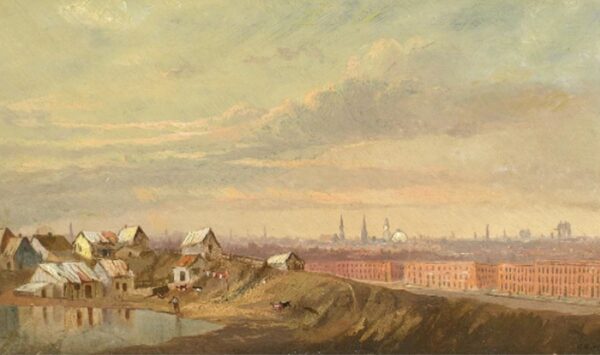
******************************************************************************************************************************** Brownstone Detectives investigates the history of our clients’ homes. The story you are about to read was composed from research conducted in the course of one of those investigations. Do you know the history of YOUR house? ******************************************************************************************************************************** Charles Day Hunt was a talented landscape painter whose work pivoted between the naturalism of the Hudson River School and the expressionism of the Tonalists. Born in Detroit, Michigan, in 1840, he eventually settled in Brooklyn, New York, around 1858 and trained under the landscape painters of the day: John F. Kensett and Alexander Wyant. Hunt’s exhibitions of oil and water color works took place from his studio at No. 75 St. James Place in Clinton Hill section of Brooklyn. Hunt’s work seamlessly blends the influences of both of his mentors in an individual style of crisp brilliance and atmospheric moodiness. Beginning in 1866 going through 1886, Hunt exhibited many times at The National Academy of Art & Design and The Brooklyn Academy of Art. He gained prominence as a member of The Black & White Club, which was a private American art association. Hunt died in 1914 in Brooklyn where, in his studio, his funeral was held. The body lay “beside the empty studio chair, pulled up before the easel,” noted the Brooklyn Daily Eagle, “on which was the picture Mr. Hunt had been working on before his seizure; the palette and oil colors were still wet.” Today, his works can be found in private and public collections, including The Brooklyn Museum […]
THE NIMBY FENCES OF COBBLE HILL (1900)
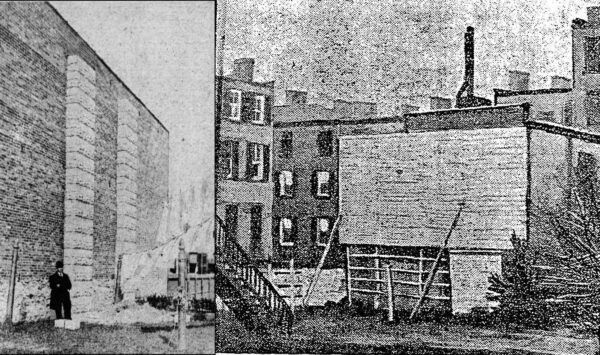
******************************************************************************************************************************** Brownstone Detectives investigates the history of our clients’ homes. The story you are about to read was composed from research conducted in the course of one of those investigations. Do you know the history of YOUR house? ******************************************************************************************************************************** “Good fences makes good neighbors.” So goes the line in Robert Frost’s poem, “Mending Wall,” which refers to the barriers people put up between themselves and others. It was also a saying favored by flinty new England farmers who thought it wise to keep their cows from straying into neighbors’ yards. When those fences ran higher than 10 feet and blocked their neighbor’s light and air, however, they tended to generate the opposite reaction – hostility. EXCHANGING HORSE NEIGHBORS FOR PEOPLE NEIGHBORS In the 19th century, Cobble Hill’s Verandah Place was a well-kept private alley within which the owners of the “mansions” on Congress and Warren Streets maintained carriage houses. When public transportation improved in the city, those horses became redundant for some. Thus, these carriage houses began to be sold to investors who, in turn, converted them, one by one, into “tenement houses.” Soon afterwards, however, the owners of these luxurious mansions abutting this alley no longer experienced the peaceful and rustic sound of the neighing of horses. They were now confronted with “squalid” tenements that attracted “far from choice” tenants. Thus, a class war had begun and those with the most means were, characteristically, intent on winning it. Faced with this new reality, the mansion owners felt that they […]
No. 4 EAST 78th ST, UES: A BRIEF HISTORY
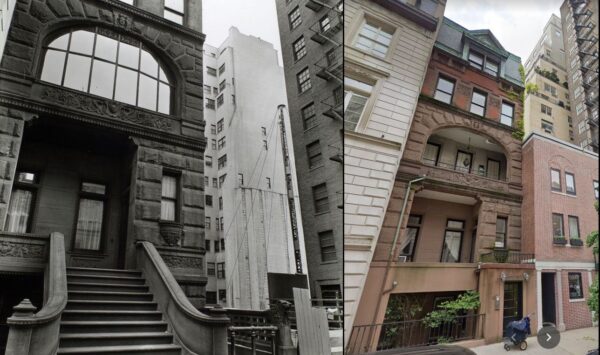
******************************************************************************************************************************** Brownstone Detectives investigates the history of our clients’ homes. The story you are about to read was composed from research conducted in the course of one of those investigations. Do you know the history of YOUR house? ******************************************************************************************************************************** According to Christopher Gray’s Streetscapes: Reader’s Questions, of the New York Times, No. 4 East 78th Street, is a Queen Anne-style house “built in 188 by the developer-architect Edward Kilpatrick. Upon completion, Kilpatrick sold it to the family of Arnold Falk, then living in a rowhouse at 129 East 64th. Mr. Falk was in the tobacco business on Water Street with his brother, Gustav, who lived in an adjacent house, 131 East 64th. On East 78th, Mr. Falk lived with his wife, Fannie, their two children and four servants. In the 1910’s and the 1920’s the house was occupied by the family of Jacob Dreicer, a principal in the Dreicer & Company jewelry firm founded in 1869, which was prominent in this period. There are now seven apartments in the building.” (New York Times, Sunday, 2 June 1991) Follow @BrownstoneDetec Share ———————————————————————————————————————– The Brownstone Detectives Brownstone Detectives is an historic property research agency. Our mission is to document and save the histories of our clients’ homes. From our research, we produce our celebrated House History Books and House History Reports. Contact us today to begin discovering the history of your home.